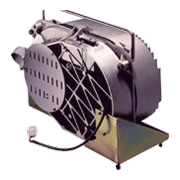The Electrical Communication Laboratories (ECL) of Nippon Telegraph and Telephone Public Corporation (now NTT) had made progress in R&D on high-capacity, high-reliability grouped magnetic disk units equipped with compact, high-density head disk assemblies (HDAs), and in 1982 they achieved practical application of a compact high-density magnetic disk unit (JS4380) (commonly referred to as PATTY: Packaged air-tight tiny disk). In terms of basic performance, PATTY had an HDA capacity of 400 MB, unit capacity of 3.2 GB, surface recording density of 24 Kbit/mm2, linear recording density of 550 bit/mm, track density of 43 tr/mm, average seek time of 18 ms, and data transfer speed of 1.344 MB/s. This unit was used in numerous systems used by Nippon Telegraph and Telephone Public Corporation and other companies. PATTY had the following features.
- 1) Sealed HDAs with a new structure were equipped with a compact 8-inch (210-mm diameter) magnetic disk, dust-removal mechanism using a newly developed rotating filter, and moisture absorption mechanism with long service life.
- 2) The signal output, quality, and reliability needed for commercialization were achieved by developing a new thin-film magnetic disk on which a magnetic film was formed via sputtering or plating using only magnetic material.
- 3) A floating gap of 0.27μm and long-term reliability were achieved by developing a floating head slider whose floating surface was made cylindrical in order to reduce adhesion.
- 4) Wind loss was reduced to 1/4-1/5 by using an 8-inch magnetic disk to replace the previous 14-inch type. Disk rotation, positioner, and dust removal mechanisms among others were integrated and housed in a sealed HDA.
- 5) Due to development of the above new technologies, periodic maintenance was unnecessary and the system could be operated continuously for five years, maintenance-free.
PATTY technology had a big impact on magnetic disk unit technology as a unique technology for high recording density and high reliability developed by ECL.



